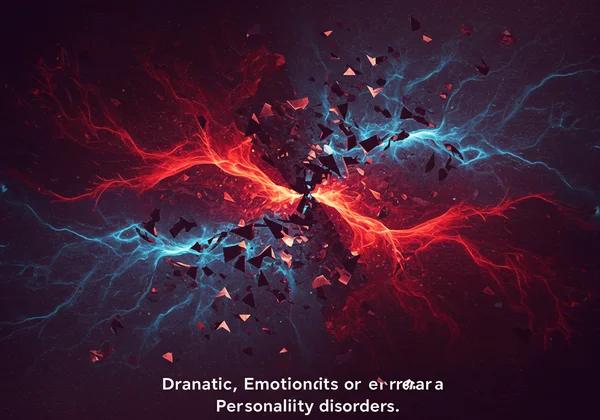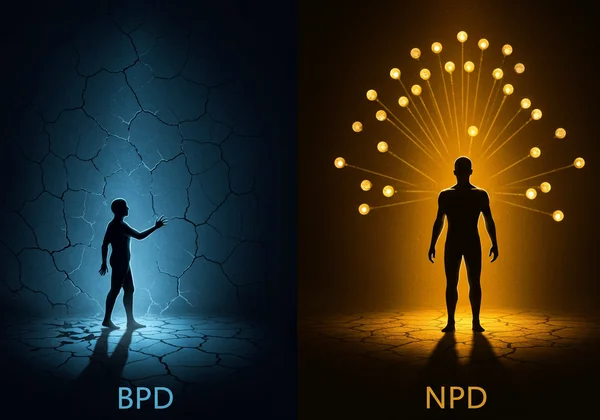B 类人格障碍测试:完整指南
你是否曾觉得自己的情绪比别人更强烈,反应更戏剧化,或人际关系更混乱?你并不孤单,心理学中有一个框架专门探讨这些经历。如果你曾问自己: “我怎么才能知道我是否有人格障碍?” ,那么你来到了一个充满理解的地方。本指南将清晰而深入地探讨 B 类人格障碍 ,帮助你找到清晰的认知,并踏上自我意识之路。迈出第一步以 获得初步见解 可能会让你感到更有力量。
什么是 B 类人格障碍?
在心理学中,人格障碍根据共同特征被分为三个类别(A、B 和 C 类)。B 类常被称为“戏剧化、情绪化或 冲动易变”的类别。具有这些障碍相关特质的个体常在冲动控制和情绪调节方面 挣扎,这会显著影响他们的人际关系和自我形象。
理解这些模式并非为了贴标签,而是为了 找到一种描述复杂经历的语言。这是进行自我反思、识别可能导致痛苦的模式的第一步。这些知识可以成为个人成长以及 帮助决定是否寻求进一步支持 的强大工具。
四种类型:戏剧化、情绪化和冲动易变的特质
B 类包括四种不同的人格障碍,每种都有其独特的特征,但都共享情绪强度和行为 不稳定性 的核心主题。它们是:
- 反社会型人格障碍 (ASPD)
- 边缘型人格障碍 (BPD)
- 表演型人格障碍 (HPD)
- 自恋型人格障碍 (NPD)
尽管它们属于同一类别,但它们的表现形式、 内在驱动因素 以及对个人生活的影响却大相径庭。

B 类与 A 类和 C 类的区别
为了更好地理解 B 类,了解它不是什么会有所帮助。A 类障碍(偏执型、分裂样型、分裂型)的特点是怪异或古怪的行为。具有这些特质的人可能显得社交笨拙或退缩。
相比之下,C 类障碍(回避型、依赖型、强迫型)的特点是焦虑或恐惧行为。这些个体常与根深蒂固的不安全感作斗争,并强烈渴望控制或 寻求确认。B 类因其戏剧性表现、冲动性和人际关系动荡的标志性特征而与众不同。
探究反社会型人格障碍 (ASPD)
当人们寻找 反社会型人格障碍测试 时,他们通常是想了解一种持续漠视他人权利和感受的行为模式。ASPD 的特点是普遍漠视和侵犯他人权利,这种模式通常始于儿童期或青春期早期,并持续到成年。
这不仅仅是 日常语境下的“不善交际”或“内向”。它涉及持续缺乏同理心,以及操纵或严厉对待他人或冷酷无情的倾向。
关键症状:漠视他人和冲动
与 ASPD 特质相关的一些核心 症状和模式 包括不遵守社会规范、欺骗性和冲动性。表现出这些特质的人可能会反复撒谎、使用化名,或为了个人利益或乐趣而欺骗他人。
常有明显的易怒和攻击性,导致肢体冲突或袭击,同时对自身或他人的安全漠不关心。也许最明确的特征是缺乏悔意;他们可能对伤害、虐待或偷窃他人表现出冷漠或将其合理化。如果这些行为让你感到熟悉,你或许可以考虑进行一次 免费筛查测试 以获取更多见解。
匿名示例:ASPD 特质如何显现
为了使这不那么抽象,我们来看一个虚构的例子。想象一下“克里斯”,一位魅力十足的销售员,他通过夸大产品功能并做出他明知公司无法兑现的承诺而在工作中表现出色。他对误导客户不感到内疚,并将其视为“游戏的一部分”。在他的个人生活中,他向朋友借钱,却无意偿还,并在被质问时变得具有攻击性。他活在当下,做出常常让他人或自己处于危险中的冲动决定,但他总能找到一个看似合理的借口来推卸责任。这说明了欺骗、冲动和缺乏悔意是如何结合在一起显现的。

理解表演型人格障碍 (HPD)
这个类别的另一个关键成员是表演型人格障碍。那些可能寻求 表演型人格障碍测试 的人,常常在与一种 强烈的、渴望成为关注焦点的需求作斗争。这不仅仅是对聚光灯的渴望;它是一种普遍存在的过度情绪化和寻求关注的行为模式。
对于具有强烈 HPD 特质的人来说,他们的自我价值感可能依赖于被他人注意到和肯定。当他们不是关注的中心时,他们可能会感到不适、不被欣赏,甚至被忽视。
核心特征:寻求关注和情绪表达
HPD 的 核心特征 体现在 这种强烈的寻求关注的需求上。这可以表现为过度戏剧化、热情洋溢和卖弄风情,即使在不适宜的情况下也是如此。他们的言语风格常常是印象派的,缺乏细节,侧重于宽泛的情绪描绘。
情绪的 波动可能很大且变化迅速,导致他人认为他们肤浅或不真诚。他们可能认为人际关系比实际更亲密,并且具有这些特质的个体极易受暗示,他们的观点和感受很容易受他人或转瞬即逝的环境影响。
HPD 与自恋:理解区别
一个常见的混淆点是表演型人格障碍和自恋型人格障碍之间的重叠,因为两者都涉及强烈的关注渴望。然而,这种渴望背后的动机是一个 关键差异所在。具有强烈 HPD 特质的人寻求 任何 形式的关注,无论是正面的还是负面的。他们希望被注意到并感到被连接,即使是通过戏剧化的表现。
相比之下,具有强烈 NPD 特质的人则特别渴望 钦佩 和赞扬。他们希望被视为优越。虽然具有 HPD 特质的人可能情绪表达丰富且依赖性强,但具有 NPD 特质的人更可能自吹自擂并对他人的感受不屑一顾。理解这些细微差别至关重要,你可以在我们的平台上进一步 探索这些特质 。
B 类中的 BPD 和 NPD 概览
边缘型人格障碍 (BPD) 和自恋型人格障碍 (NPD) 可能是 B 类中讨论最广泛的病症。两者都在情绪调节和人际关系方面带来显著挑战,我们基于科学的 人格障碍测试 涵盖了与两者相关的指标。

边缘型人格障碍 (BPD):对遗弃的恐惧和不稳定
BPD 的定义是人际关系、自我形象和情绪方面的普遍不稳定模式,以及显著的冲动性。一个核心特征是对被遗弃的强烈恐惧,无论是真实的还是想象的。这可能导致不顾一切地努力避免被独自留下,从而形成一种不稳定而激烈的人际关系模式,这种模式可能在理想化(“你很完美”)和贬低(“我恨你”)之间循环。其他特质包括不稳定的自我意识、长期的空虚感以及强烈、不恰当的愤怒。
自恋型人格障碍 (NPD):对钦佩的需求和缺乏同理心
NPD 的特点是普遍存在的浮夸、对钦佩的需求以及深度缺乏同理心。具有这些特质的个体常有夸大的自我重要感,夸大成就并期望被认为是优越的。他们沉迷于无限成功、权力或理想爱情的幻想,并认为自己是“特殊”且独一无二的。然而,这种浮夸往往掩盖了脆弱的自尊,这种自尊极易受到最轻微的批评。
迈向清晰和自我意识的第一步
驾驭 B 类人格障碍的复杂世界可能会让人感到不知所措,但理解这些模式是勇敢而至关重要的第一步。知识让你能够理解自己的经历,改善人际关系,并培养自我同情。本指南旨在作为教育的起点,而非诊断工具。
如果这些描述中的任何一个引起了你的共鸣,那么下一步是温和的自我反思。为了帮助这一过程,我们开发了一个免费、保密且基于科学的筛查工具。进行我们的 人格障碍测试 可以为你提供关于你的特质和行为模式的初步见解,提供一个结构化的方式来更好地了解自己并规划下一步。
免责声明: 本文仅供参考,不能替代专业的医疗建议、诊断或治疗。我们网站上的筛查工具旨在作为初步的自我评估指南,不提供诊断。如需全面评估,请咨询合格的心理健康专业人士。
关于 B 类障碍的常见问题
具有 B 类人格特质的人行为如何?
具有 B 类人格障碍特质的人常表现出被他人认为是戏剧化、情绪化或 冲动易变 的行为。这可能包括强烈的情绪爆发、冲动行为(如鲁莽消费或滥用药物)、不稳定的人际关系模式、强烈的寻求关注需求,或对他人感受和安全的漠视。具体行为在四种类型(ASPD、BPD、HPD、NPD)之间差异显著。
什么会引发人格障碍?
没有单一的原因,“触发因素”通常是多种因素而非单一事件的累积结果。研究表明,人格障碍是由遗传、环境和大脑化学的复杂相互作用发展而来的。诸如精神健康状况家族史、童年虐待或忽视经历、在不稳定或无效环境中成长以及某些大脑结构差异等因素都可能增加风险。
最准确的人格障碍测试是什么?
诊断人格障碍最准确和权威的方法是由合格的心理健康专业人士(如心理学家或精神科医生)进行的全面临床评估。这包括深入访谈、个人病史回顾以及通常使用的标准化诊断工具。然而,对于那些寻求初步了解的人来说,便捷的在线筛查工具可以是一个有价值的第一步。我们的 免费人格障碍测试 是基于科学设计的,旨在提供初步见解,帮助你决定寻求专业帮助是否是适合你的下一步。